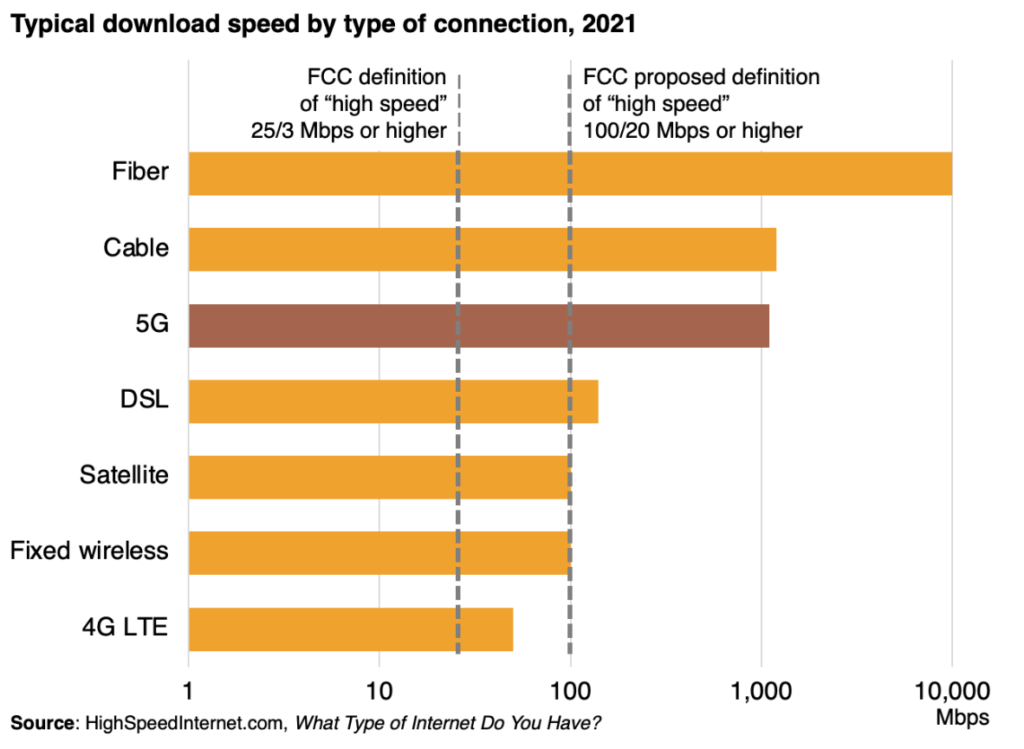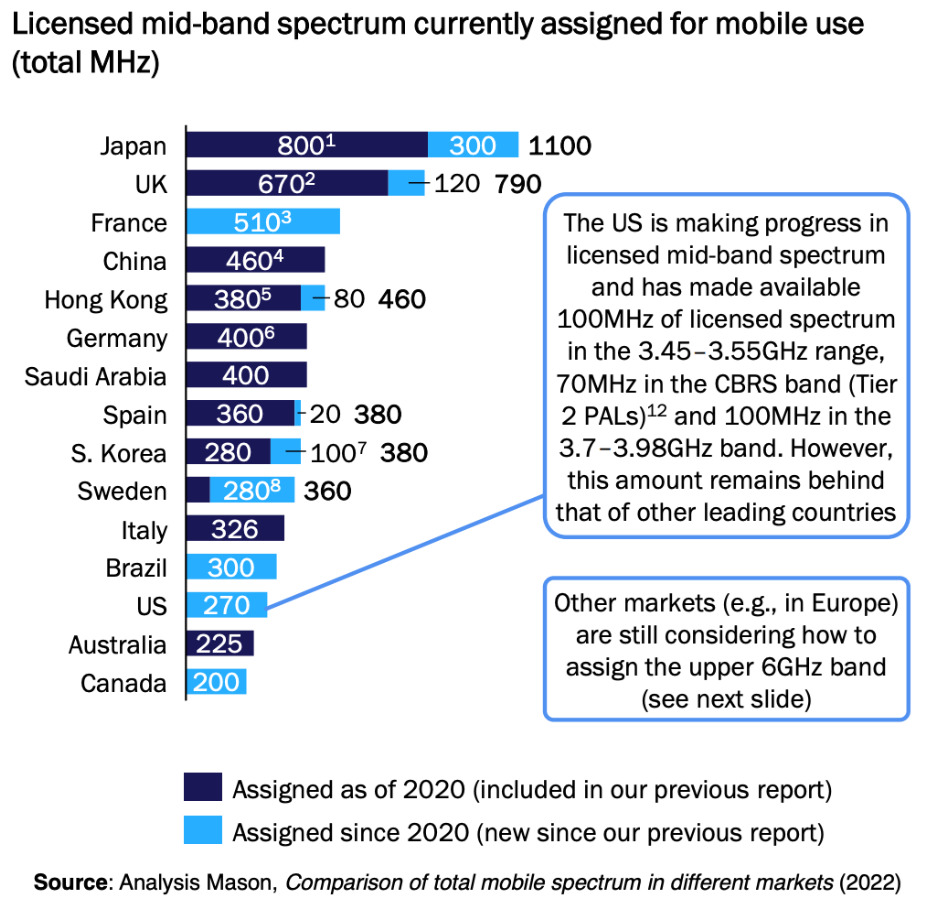
Hootenannies are mostly peaceful affairs, so it’s a bit awkward to invoke a violent metaphor here.
In “Raiders of the Lost Ark,” Indiana Jones runs down a Cairo sidestreet only to be confronted by a swordsman. The swordsman makes a big show of tossing his weapon from hand-to-hand and swirling it around. But Indy has no time for such nonsense—he pulls out his gun and shoots the would-be assassin.
U.S. spectrum policy is much like the swordsman. While the telecom regulators swirl around studies of how to allocate spectrum, the rest of the world is pulling the trigger.
For years, the United States—and the rest of the world—have been racing to deploy 5G wireless technology. The technology promises download speeds about 100 times faster than 4G. With speeds on-par with high-speed cable, the expansion of 5G will enable transformative new technologies like self-driving cars, telemedicine, and virtual reality. That’s why the technology is expected to contribute $13.2 trillion to the global economy by 2035, according to IHS Markit.

Yet rolling out 5G at scale requires wide channels of wireless spectrum not previously used for commercial broadband. The ideal spectrum for 5G lives in the so-called mid-bands from 3-7 GHz, according to Accenture.
But therein lies the challenge: these bands already have legacy federal and satellite users. Clearing this mid-band spectrum so that it can be auctioned for 5G is proving difficult within the congested U.S. regulatory system.
Falling Behind in the Mid-Band
While the United States led in early 5G deployments, critics argue that the country has fallen behind in making mid-band spectrum available. According to research published by telecom trade association CTIA, many of America’s trading partners have much greater licensed mid-band spectrum assigned for mobile use.
The result is that it’s estimated U.S wireless operators need at least another 1,500 MHz of licensed mid-band spectrum to meet consumer demand and be competitive globally. Without sufficient spectrum, the United States will struggle to keep pace with both partners and rivals in deploying the next-generation 5G networks that will be critical to 21st century telecommunications infrastructure.

The Biden administration has recognized the need for more mid-band spectrum access. This week, it released its National Spectrum Strategy to modernize U.S. spectrum policy and meet future wireless demand. The strategy identifies five bands totaling 2,786 MHz of spectrum for further study:
- 3.1-3.45 GHz: Recently studied for sharing with the private sector. More analysis is needed on dynamic sharing tools.
- 5.03-5.091 GHz: Study optimal use for drone operations while protecting other uses.
- 7.125-8.4 GHz: Assess opening up spectrum currently used for federal users like government satellites.
- 18.1-18.6 GHz: Align with global policy to expand satellite operations after an upcoming international conference.
- 37-37.6 GHz: Look at spectrum sharing between federal agencies like the U.S. Defense Department (DOD) and private users.
“Further study” is doing a lot of heavy lifting here.
While the administration should be applauded for identifying a need to address spectrum strategy, critics argue that the plan is more analysis than action. They contrast it with the prior administration releasing more than 6,000 MHz of high-band spectrum for 5G and opening up swaths of unlicensed spectrum.
A Study Is Not a Plan
The leading critic has been Federal Communications Commission (FCC) member Brendan Carr, who notes that the Biden strategy fails to commit any tangible spectrum to commercial use.
“After nearly three years of study, the Biden Administration does not commit to freeing up even a single MHz of spectrum,” Carr said. “Instead, they are announcing that they will continue studying the issue for years to come.”
Carr argues that other countries are currently licensing far more mid-band airwaves for 5G while the U.S. market is mired in studies.
“While America is standing still, our global competitors and adversaries are passing us by,” Carr warns. “They are executing on actual spectrum plans that are putting actual spectrum to use in their countries.”
Carr called on the FCC to put forward an actual plan that identifies specific bands and a rapid timeline for clearing them through auction. Toward that end, he points to his own detailed spectrum plan, laid out a little more than two years ago. It prioritizes near-term action on bands like 3.45 GHz, 2.5 GHz, and others. He also discussed the need for infrastructure reform, and warned against outdated regulations.
Will Encumbered Bands Be Cleared?
The crux of the debate centers on whether the most coveted mid-band spectrum can realistically be cleared of federal users anytime soon. Carr believes bands like the lower 3 GHz range (3.1-3.45 GHz) studied by the Pentagon can and must be auctioned quickly. But the DOD counters that freeing up spectrum from military radar systems could take years.
In addition, the administration’s strategy omits some critical bands altogether, like 4 GHz. Incumbent satellite users also occupy other bands that industry desires. The 7 and 8 GHz range holds promise, but sharing sensitive federal systems will prove challenging.
While much of the discussion regarding advances in 5G focuses on competing against other countries, a more important question may be how to advance 5G technology to compete and cooperate with other countries.
Many of our trading partners license the 6 GHz range for mobile use. But in the United States, much of that range is allocated for unlicensed uses. Freeing a portion of the 7 GHz range would get the United States closer to harmonizing with other countries’ networks. We don’t live in a zero-sum world.
While the Biden administration contends its strategy is a “positive first step,” the administration’s leadership is necessary to take action to free spectrum from use by federal agencies. Deploying globally harmonized 5G spectrum is crucial to both competing against rivals and working with partners. We don’t want to be left in the street like Indy’s showboat swordsman.




